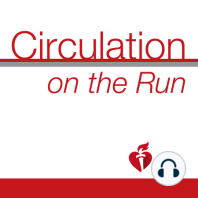17 min listen
Circulation May 22, 2018 Issue
ratings:
Length:
21 minutes
Released:
May 22, 2018
Format:
Podcast episode
Description
Dr Carolyn Lam: Welcome to Circulation On The Run, your weekly podcast summary and backstage pass to the journal and its editors. I'm Dr. Carolyn Lam, Associate Editor from the National Heart Center and Duke National University of Singapore. Our featured discussion today centers on the challenges of cardiovascular disease risk evaluation in people living with HIV infection, an important discussion coming right up after these summaries. The first original paper this week provides experimental evidence that nicotinamide riboside could be a useful metabolic therapy for heart failure. First author Dr. Diguet, corresponding author Dr. Mericskay, from University Paris-Sud investigated the nicotinamide adenine dinucleotide or NAD homeostasis pathways in the failing heart. They found that an expression shift occurs in both murine and human failing hearts in which the nicotinamide riboside kinase two enzyme, which uses the nucleoside nicotinamide riboside was strongly up-regulated for NAD synthesis. Nicotinamide riboside supplemented diet administered to murine models of dilated cardiomyopathy or pressure overloaded induced heart failure restored the myocardial NAD levels and preserved cardiac function. Nicotinamide riboside increased glycolysis as well as citrate and Acetyl-CoA's metabolism in these cardiomyocytes. Thus, nicotinamide riboside supplemented diet may be helpful in patients suffering from heart failure and may help them to cope with the limited myocardial ATP supply by restoring NAD coenzyme levels and its associated signaling. In the single ventricle reconstruction trial, one year transplant-free survival was better for the Norwood procedure with the right ventricle to pulmonary artery shunt compared with the modified Blalock‒Taussig shunt in patients with hypoplastic left heart and related syndromes. In the paper in this week's journal, authors compare transplant-free survival and other outcomes between these groups at six years. First and corresponding author Dr. Newburger from Children's Hospital Boston and her group showed that the right ventricular pulmonary artery shunt group had similar transplant-free survival at six years, but required more catheter interventions before the Fontan procedure. Right ventricular ejection fraction, New York Heart Association class and complications did not differ by shunt time. Cumulative incidences of morbidities by six years included 20% with a thrombotic event, 15% with a seizure, and 7.5% with a stroke. These data therefore emphasize the importance of continued follow-up of the cohort, and the need to find new strategies to improve the long-term outlook for those with single ventricle anomalies. The next paper presents results of the CREATIVE trial, which stands for Clopidogrel Response Evaluation and Anti-Platelet Intervention in High Thrombotic Risk PCI Patients). First and corresponding author Dr. Tang from Fuwai Hospital National Center for Cardiovascular Diseases, Chinese Academy of Medical Sciences and Peking Union Medical College conducted a head-to-head comparison of the safety and effectiveness of intensified anti-platelet therapies either a double dose clopidogrel or adjunctive cilostazol and conventional strategy in 1078 post-PCI patients at high thrombotic risk as identified thromboelastography, which is a platelet function test. The primary outcome was the incidence of major adverse cardiac and cerebral vascular events at 18 months post-PCI they find as a composite of all cause death, myocardial infarction, target vessel revascularization, or stroke. The authors found that the primary end point occurred in 14.4% of those in the conventional strategy. 10.6% in tho
Released:
May 22, 2018
Format:
Podcast episode
Titles in the series (100)
Circulation January 24, 2017 Issue: Circulation Weekly: Your Weekly Summary & Backstage Pass To The Journal by Circulation on the Run
